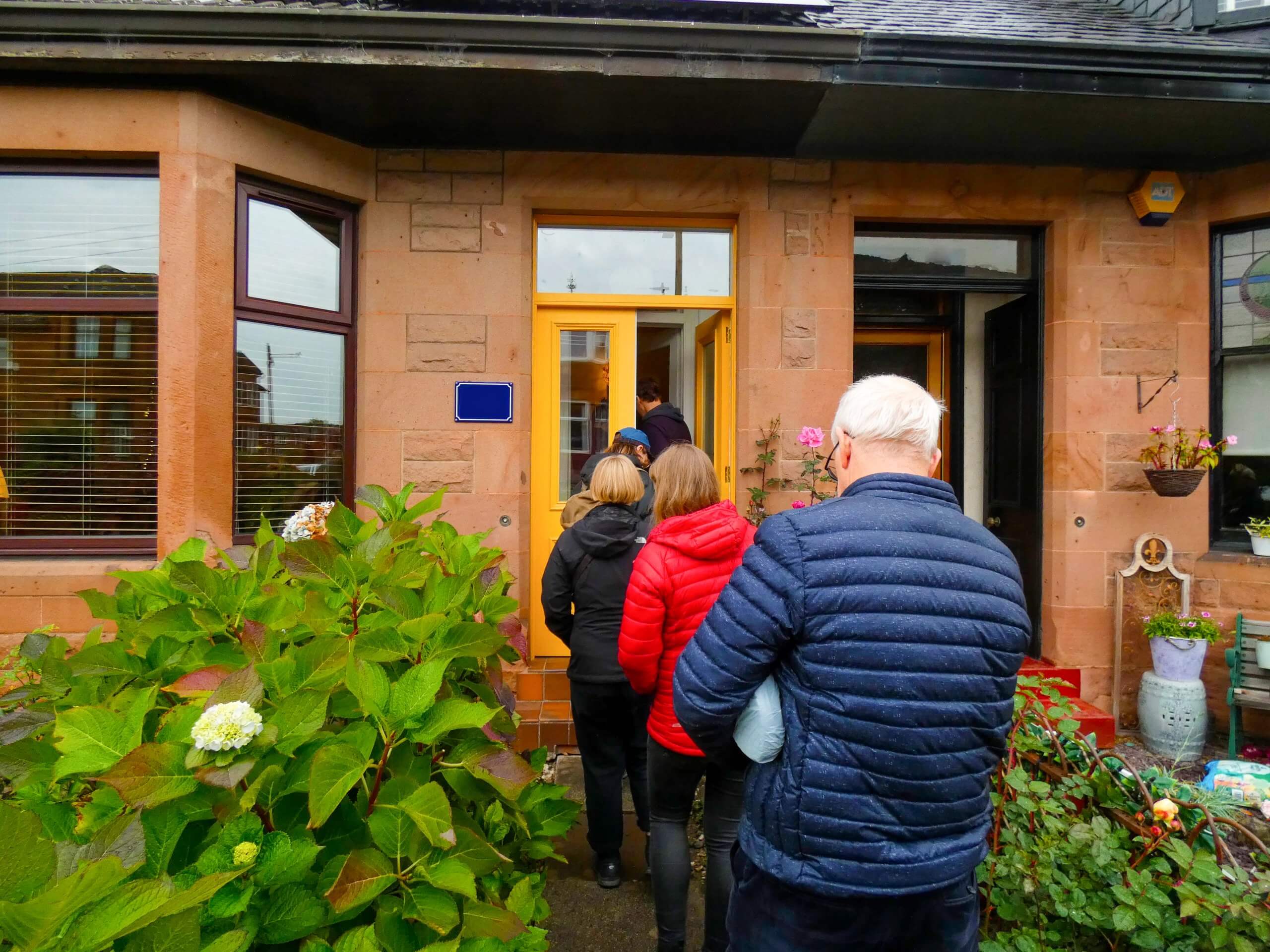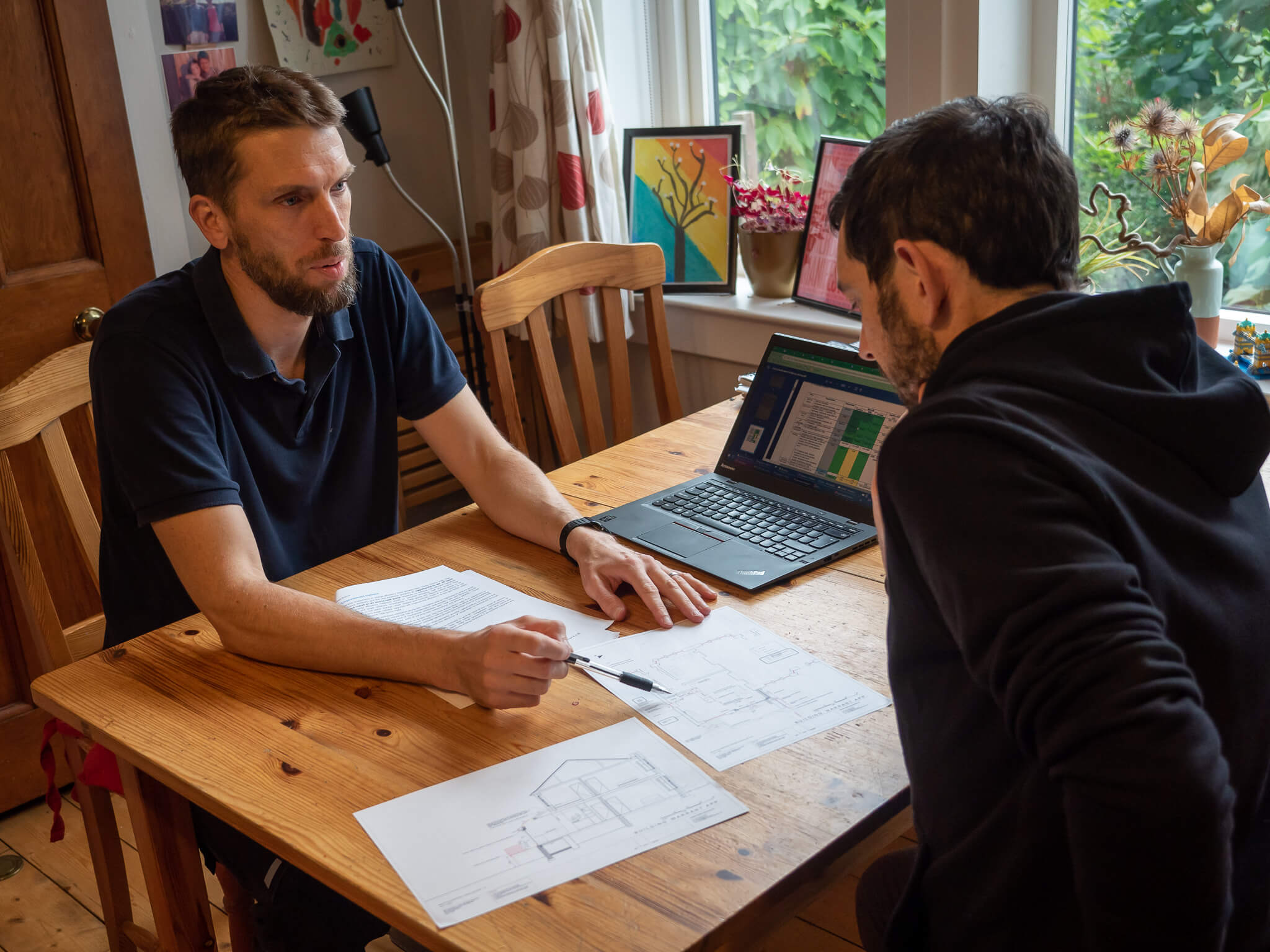
PREPARATION
Nina and Josef bought their home in June 2014 but didn’t initially have the resources for renovations. During the COVID pandemic, the couple moved to Essex for 18 months due to work, with tentative plans to start work on the house while they were away. When the kitchen ceiling collapsed, these plans escalated.
“We were originally thinking of replacing the galley kitchen,” says Nina. “But it soon started growing arms and legs.”
Nina’s parents, early adopters of renewables who have had solar panels since Nina was a child, was a true inspiration for the couple. “They have always been real innovators in that sense,” says Nina.
The couple decided to “go the whole hog” and open up the kitchen, which required removing all the radiators. This prompted a decision about heating.
“I couldn’t bring myself to buy a new gas boiler in this day and age. We are conscious of these things and want a more efficient home. We thought, if we’re going to do all this work, let’s do the full thing. Then we found out we were pregnant,” says Nina.
Instead of putting a halt to the work, this news expanded plans to the next level.
“We decided to add another bedroom. We suddenly saw this as a family home, whereas before, it was just our first home together,” she adds.
“I couldn’t bring myself to buy a new gas boiler in this day and age.”
Funding
Nina contacted Home Energy Scotland in January 2022 and began getting quotes from contractors. Home Energy Scotland were helpful,” says Nina. “They did an assessment over the phone and provided a report and some recommendations.
The couple then used Home Energy Scotland’s database to find a contractor. As part of the loan application, the couple had to provide at least two quotes for each element they were applying for.
“You have to submit your quotes along with quite a lot of paperwork and your EPC [energy performance certificate],” says Nina.
“They say it takes ten days, but it took us two months to get a decision,” she adds.
The loan application stalled due to a contractor’s lapsed accreditation for solar, which led to their MCS [Microgeneration Certification Scheme] number not being valid.
“I was on the phone for hours,” says Nina. “I work in policy and advocacy, and I had to advocate hard to get that loan application processed.”
As the delay drifted into April and May, Nina tried another tactic. “I eventually had to use the pregnancy card. I was due in August, and we hadn’t even started the work apart from the builders knocking down walls and pulling up floors.”
Eventually, after much chasing, the issue around the MCS number was uncovered. The couple removed the solar installation from the application and secured the loan and cashback for the heat pump and insulation [both underfloor and room-in-roof].
“In the end, we paid for the solar ourselves,” says Nina. “It cost just over £5,000.”
The cost of the heat pump, radiators, and heating system was around £13,000. “Of that, we got £7,500 cash back and £3,000 loan, which we’re paying back interest-free over 12 years,” says Nina. “It’s pretty good – £47 goes out of our account every month.”
WORK
Nina and Josef initially thought they could live in the house while the work was completed, but it soon became apparent that it wouldn’t be possible. Thankfully, Josef was still working in Coventry, and Nina had family around her.
“My brother and his girlfriend moved in together,” says Nina. “And I moved in with them the next day and lived there for four months while all this work was being done.”
Due to the amount of building work needed, including installing a new bathroom and upstairs bedroom and knocking down kitchen walls, the process was quite disruptive.
“It doesn’t necessarily need to be that way,” says Nina. “Especially if you’re not doing that much building work.”
“These houses have a cavity underneath,” says Nina. “That meant they could go in and do the underfloor installation from there, so that made that quite easy.”
The work started in March 2022, and the couple were able to move back in at the beginning of August, just weeks before their son was born. The solar panel work was completed in October of that year.
It doesn’t necessarily need to be that disruptive, especially if you’re not doing that much building work.
RESULT
Both Nina and Josef are delighted with the result and have noticed a difference in the feel of their home. “It’s just cosy. It sits at 19 degrees, and it’s amazing,” says Nina.
The underfloor heating has transformed the living room. “Josef would never use this room because he’d sit by the window in winter and it would be freezing.”
The couple wasn’t motivated by saving money. Considering recent rises in the price of electricity, they’ve found that, on average, they spend a similar amount across the year as before.
“Ultimately, we’re so happy we did it. It was so worthwhile,” says Nina.

Insights
A mutual friend introduced Nina to Tom Nockolds [Co-Founder and Co-Executive-Officer of Loco Home Retrofit] in May 2022.
“When we finished our work, we participated more with Loco Home and shared our story in the hope that others would see that it’s possible to do all this without that much knowledge.”
Nina feels the structure of the funding process may act as a barrier for many people. “My mum and dad had to loan us money because we had a problem getting the payment of the loan and cashback after the work,” she says.
“You must submit proof of payment and all your invoices to get the cashback and the loan paid. We had about a month where we needed about £10,000 before we were paid. We are privileged to have parents who can offer £10,000 to tide you over. I don’t know if they’ve changed that now, but it was the process at the time.”
Nina says that if they did it all again, they would get more informed about the options and different systems available. “That was one of the challenges. We were reliant on the installers and their knowledge. Now that I know Loco Home, I would get a home assessment done by an independent, trusted body with expertise before spending all this money.”
Now that I know Loco Home, I would get a home assessment done by an independent, trusted body with expertise before spending all this money.
Words by Scott Skinner

MAKE A PLAN
Loco Home’s Whole House Assessment services are helpful to anybody who is stuck with their retrofit or simply unsure where to start. To learn more, listen to Loco Home member Sarah Buchannan talk about her assessment on the Accelerate to Zero podcast, or click below.

